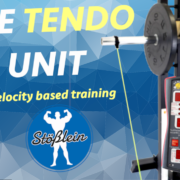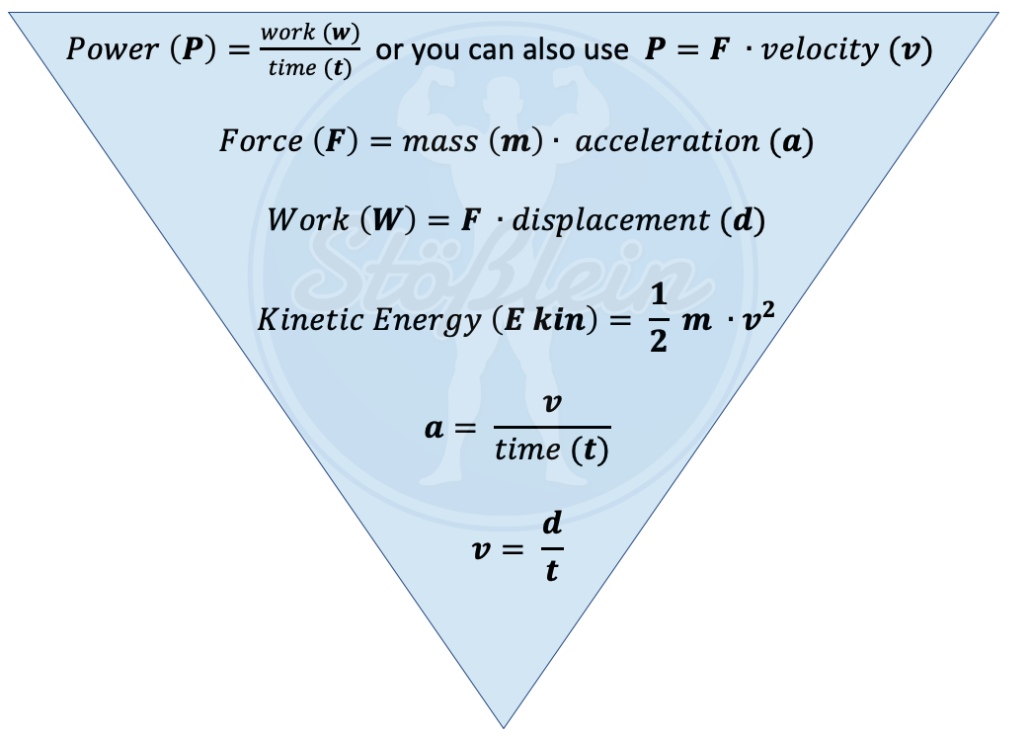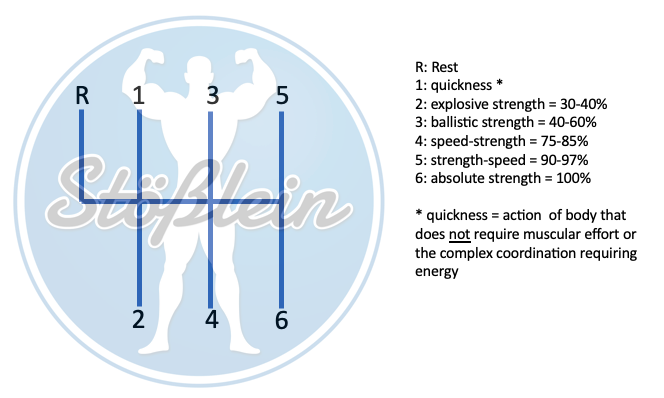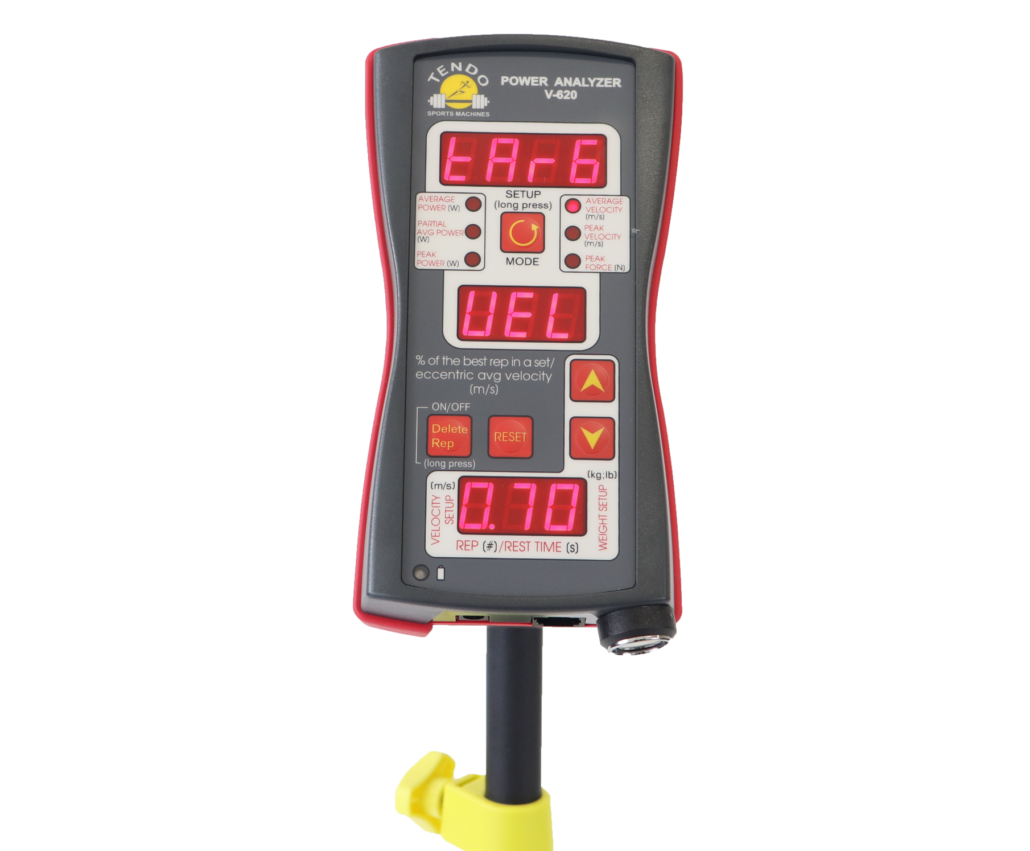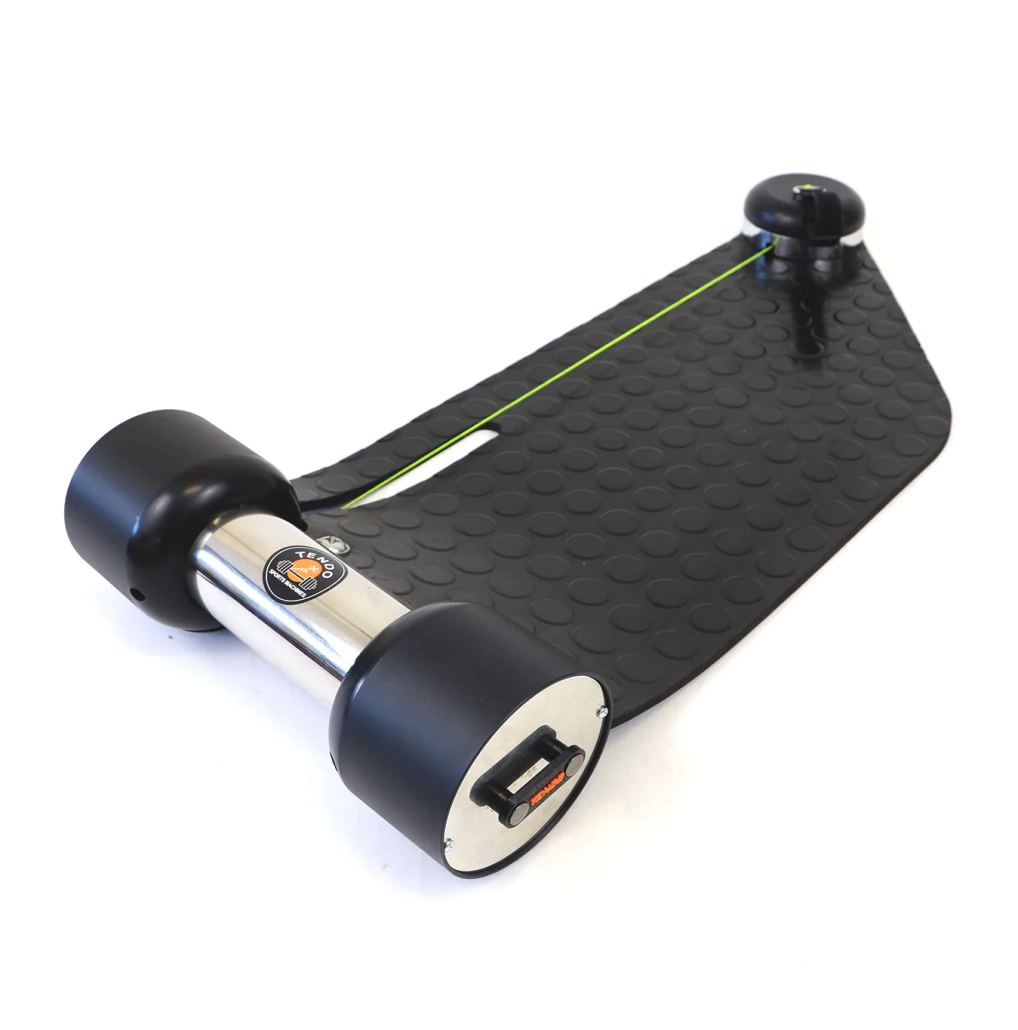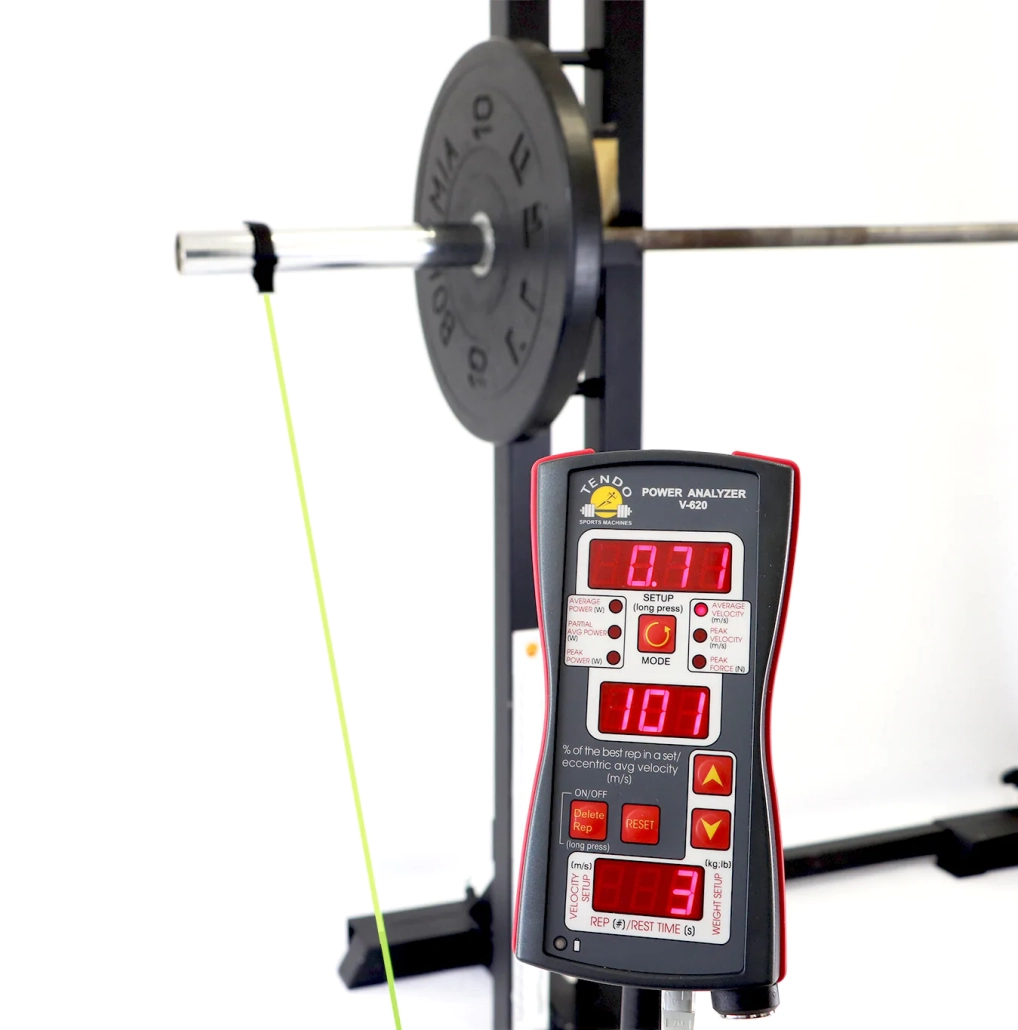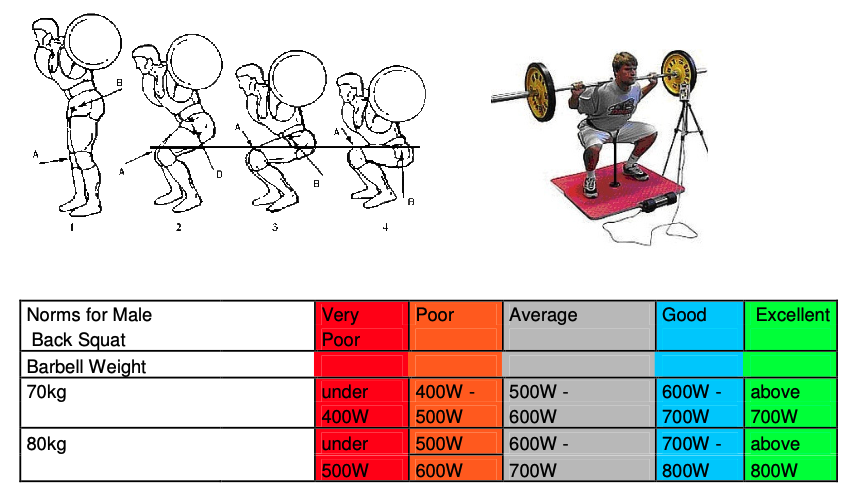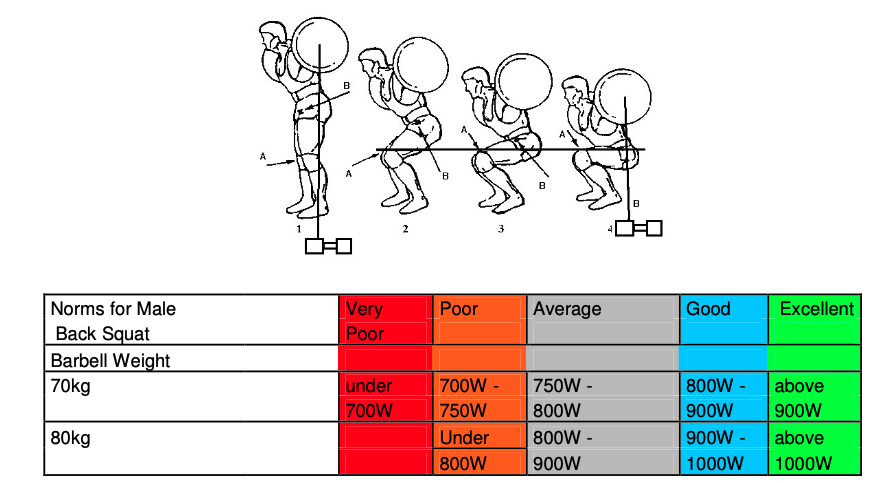TENDO UNIT is a computer system that eliminates the guesswork of athletic training. Using this device you can optimize your strength-training, respectively your velocity based training. Strength is not measured in “heavy” or “light” but in speed/velocity! Force (F) = mass (m) x acceleration (a). To get stronger you need to lift heavier weights, but you also need a faster production rate of force! So, besides absolute strength, you must also pay attention to other special forms of strength, like i.e. explosive-strength, speed-strength and/or strength-speed. But, how do you know if you have the optimal bar-speed for each special strength? By using a TENDO unit!
Henceforth you’ll be able to measure bar-speed and investigate whether you’re strong but slow or vice versa! And what gets measurable gets manageable! Doing the same you have always done and hoping for change is Einstein’s definition of insanity! Hence, if you want to know why it’s useful to also train for things like speed-strength and explosiveness to optimize an athlete’s performance you will find lots of info in this article.
Enjoy!
Strength-Training is NOT Bodybuilding. You should know the difference!
If you’re reading this article you’ve probably searched for A) either more info about a TENDO unit or B) about velocity based training. Maybe also both. Perhaps you “just” stumbled over my article, as you’re eager to learn more about how to take out the guesswork of your athletic based training.
Either way I’d like to stress that athletic training, respectively strength-training is NOT Bodybuilding!
I’ve seen lots of “weekend-warriors”, “gym-rats” and even self-proclaimed “trainers/coaches” who still don’t understand these fundamental differences and to whom every form of training is bodybuilding! To all you Social-Media “fitness- gurus”, it would be a lot cooler if you knew what you’re talking about!
This article is not about those aforementioned differences, yet – in a nutshell – and to make a long story short, I’d like to stress the differences in just a few sentences, again!
Bodybuilding is about “aesthetics”, whereas strength-training is about athletism!
Furthermore, Bodybuilding-Training is NOT about being quick, having reversal strength nor explosiveness. Bodybuilders don’t use a stretch-reflex either, keep this in mind!
Bodybuilding is rather about training muscles (peripheral nervous system = PNSà increase of muscle thickness = hypertrophy ) than the Central Nervous System (CNS).
Only in terms of Hypertrophy (Bodybuilding) it makes sense to lower or raise a weight slowly (to eliminate the stretch-reflex).
Of course you can lower a weight significantly slower than raising it, but – again – if you’re performing in an athletic sport in which it’s of importance i.e. how fast you run, how high you jump or how far you throw you also need to have a fast force production rate (acceleration)!
Therefore bodybuilding-training won’t make you a better athlete. It might help you to look better naked, but this training-method is only of use if you want to do bodybuilding, which – again – has ZERO athletic components! Bodybuilding shows are NOT won by the whom who is i.e. the strongest or the fastest!
This Article is not intended to put Bodybuilders down, nor do I have the time to focus on explaining (again) in detail the essential differences between aesthetic training (Bodybuilding) and athletic training for sports.
But please keep in mind that NOT EVERY KIND OF LIFTING WEIGHTS EQUALS BODYBUILDING, respectively hypertrophy!
Strength is measured in speed/velocity!
Strength-training basically is simple physics, biomechanics and physiology. In order to understand how you benefit from using a TENDO unit we must have a look at some physical formulas first. But don’t worry, I’ll give you my little Stoesslein-Strength cheat-sheet.
As mentioned above, strength isn’t measured in subjective terms like “light” or “heavy”, but in objective terms like velocity, respectively e.g. in meters per second (m/s).
In the following picture you’ll find an overview about some special strengths, using a manual stick shift/gear in a car as analogy. Like in a car you’ll have to shift those gears and reach the optimal rounds per minute for each gear, before shifting up or down.
Of course you cannot drive in two gears simultaneously. That’s like taking a shower and trying to dry yourself at the same time!
Hence it should be clear that you must choose the “right” amount of weight AND speed for each specific special strength or you might end up in the wrong “gear”. I don’t sell cars, but I hope you buy this idea!
So, to make this even a little clearer. Let’s say you want to train for speed-strength (gear 4 in our example) you must choose a weight that’s at least 75% and maximally 85% of your one repetition maximum (1 r.m.)!
If the weights are heavier (above 85%) or lighter (below 75%) you’ll end up doing something else as intended.
But, let’s say you stay within the range of 75%-85% for speed-strength you still want to have optimal “bar-speed” (which would equal the optimal rounds per minute in gear 4 in our example).
To be precise, for speed-strength you need to move your bar with at least 0,7m/s and max. 0,9m/s, which makes it an average of 0,8m/s!
Keep in mind: for a special-strength you need the right “gear” (percentage of 1 r.m.) AND the right “rounds per minute” (bar speed) in this gear! But how do you know? Of course you could calculate your percentage of 1 r.m. but how do you measure your bar speed?
That’s where the TENDO unit comes into play!
We stick to our speed-strength example. You now know that, in order to become stronger, you must also become faster, as Force (F) is mass (m) x acceleration (a).
Therefore you decided to also include speed-strength training into your workout.
From the stick-shift gear-analogy above you now know, that speed-strength is trained in the range of 75%-85% of your 1.r.m., which makes it an average of 80% of 1 r.m.
So, let’s say you can do e.g. a raw bench-press of 150kg, this would equal your current 1 r.m.
To train for speed-strength you would have to calculate 75%-85% of this current 1 r.m. Making things easier we assume you use a three-week pendulum wave in a Westside
Barbell (so called “dynamic effort”) manner, like the following:
Week 1: 75% = 112,5 kg Week 2: 80% = 120 kg Week 3: 85% = 127,5 kg
Westside Barbell modifies speed-strength training, mainly by adding jump-stretch bands, in order to create what they call an “overspeed-eccentric”. They attach those bands with a specific band tension to the bar, to create a faster eccentric phase.
This would be like firing a marble with a slingshot perpendicular to the ground, instead simply letting drop it! Hence, you create more kinetic energy (see Stoesslein Strength cheat sheet).
According to that (Westside Barbell dynamic effort), and to stick to our bench-press example, the three-week pendulum speed-strength wave would look like this:
Week 1: 50% bar weight + 25% band tension at lockout = 75% = 112,5kg total Week 2: 55% bar weight + 25% band tension at lockout = 80% = 120kg total Week 3: 60% bar weight + 25% band tension at lockout = 85% = 127,5kg total
To be precise, you would have to attach the band in such a manner that you will still have about 10% of band tension at the bottom of the movement!
So, the precise theoretical numbers of our 150kg example bench press would look like this:
Week 1: 50% bar weight (75kg) + 25% band tension at lockout (37,5kg) = 75% = 112,5kg Week 2: 55% bar weight (82,5kg) + 25% band tension at lockout (37,5kg) = 80% = 120kg Week 3: 60% as bar weight (90kg) + 25% band tension at lockout (37,5kg) = 85% = 127,5kg
I selected the Westside Barbell on purpose to demonstrate that simple theoretical math won’t do the job if you want to do velocity based training and why you need a TENDO unit to really know if you’re not just doing the right THINGS, but if you’re also doing the right THINGS RIGHT!
I won’t discuss the Westside Barbell method in this article any further. If you want to learn more about their “conjugate method” I’ll highly recommend you doing so!
But their “dynamic effort” method and our 150kg example of a 1 r.m. raw bench press will perfectly show why simply doing something doesn’t necessarily produce results.
So, let’s say you’ve done the aforementioned calculus. You can bench press 150kg raw for once and want to add speed-strength training now.
You’re in week one, you use 75kg of bar weight and plates and attach bands to reach 25% band tension at lockout (37,5 kg) and you think you’re automatically doing speed-strength training now. But, guess what, you’re probably not!!!
If you cannot move these weights fast enough (average of 0,8m/s) you’re NOT DOING SPEED-STRENGTH work ALTHOUGH you have reduced the bar weight and attached bands!
You must monitor your velocity, and that’s why you should use the TENDO unit! This device will tell you exactly if you’re too fast or, most likely, too slow for i.e. speed-strength training!
Maybe your bar speed is only 0,4 m/s ALTHOUGH you have set up the weights/bands correctly for speed-strength, but then you’re simply too slow.
Then you have indeed set up the weights/bands for speed-strength in theory but in reality you lack a fast rate force production and will end up doing something else, but not speed strength!
This is the difference between theory and actually doing something in reality! Keep in mind: Assess don’t guess!
„Increasing bar speed is most important, not raising the bar weight. (…) A faster bar equals more force.“ (Simmons, 2007).
As mentioned above, you might do the right THINGS, but only with monitoring speed you identify if you do the right THINGS RIGHT! This is the difference between being effective (doing the right THINGS) and being efficient (doing the right THINGS RIGHT)!
TENDO Unit – How does it work?
Now that you have (re)learned about special strengths and after hearing a lot about why you should monitor your bar-speed, you probably want to know how a TENDO unit actually works, right?
The original TENDO unit is a microcomputer (see picture above), that can be magnetically attached either on a tripod, rack, rig or whatever you want (unless it’s magnetic). The computer’s data cable is connected to a measuring device (sensor unit).
The sensor (see picture above) unit contains a Kevlar cord, which can be attached to a bar or lever arm of a machine, human (while jumping) etc. The possibilities are numerous!
“The Tendo Unit – WL also offers a possibility to attach the sensor unit string safely on a special waist belt and measure leg’s power and velocity without positive influences of the back extension, i.e. it gives you the possibility to use the Tendo JumpMat.” (TENDO).
In this article I won’t tell you how to go through the whole menu of a TENDO Unit as you simply can download the instruction manual on their website if you wish to.
I don’t sell TENDO units, but I hope you buy the idea of the importance of velocity based training in order to get stronger!
Prof. Dr. Dr. Dietmar Schmidtbleicher is justified in saying: “Maximum Strength is the mother of all strength qualities”. Therefore, in order to get stronger, you eventually have to move heavier and heavier weights!
Loui Simmons (Westside Barbell) also thought of the max effort method as the superior way to get stronger, when he wrote: “Absolute strength controls all strength gains!” (Simmons, Books of Methods, p. 195).
BUT, please remember that Force (F) = mass (m) x acceleration (a)! Which leads us to the question: Can you be TOO strong?
Well, yes and no! Of course, on the one hand, you cannot have something like too much strength (as you cannot have too much energy in general) but on the other hand, if viewed from an athletic perspective, you must not sacrifice speed for strength, but neither vice versa!
It’s not a question of either or but rather of as well as…you must train and improve both, strength AND speed, as Force (F) is the product of mass (m) times acceleration (a)!!!
To learn more about this topic I suggest investigating the so called strength-velocity curve.
Just go to the internet and enter “strength-velocity curve” or, i.e. check Mel Siff’s book “Supertraining”, p. 150.
Both special strengths (speed-strength and absolute strength) should be trained simultaneously (but not in the same workout).
For constant improvement you should choose an optimal method, like the Westside Barbell “conjugate method”, instead of outdated methods like i.e. “block periodization”. Just as a side note.
But back to the TENDO Unit and its measurements. Of course the speed of your eccentric and concentric movement is of importance, but it’s also of value to measure how much Power (measured in Watts) you produce!
How much power you produce is important to check in order to see how efficient you are. Recap my Stoesslein Strength cheat sheet to see the formulas for Power.
Here’s a little example: Power is work/time. Let’s say you do 10 exercises in 60 Minutes. If you did the same 10 exercises in 45 minutes, you would have been more powerful, as you would have done the same workload in less time!
So, if you want to check how powerful you are, you can adjust the weight you’re going to move on the TENDO Unit and it will measure how much Watts you’ve produced.
Here’s a little Back Squat example test you could do (with friendly permission by TENDO) to measure the maximum average power for assessment of strength for the lower body for (male) Athletes:
The string of the sensor unit is attached on a waist belt.
- – Measurement of the maximum average power for back squat
- – Load 70 kg and/or 80kg.
Assessment: Evaluation of maximal strength for back squat by measuring maximum average power
Equipment: Microcomputer system Tendo Weightlifting Analyzer, Tendo Waist Belt
Methodology:
– The sensor unit string is attached on a Tendo Waist Belt from front position of the player, in height under the hip, to avoid positive influence of back extension on power measurement.
– The subject performs a controlled back squat until the upper thigh is parallel to the floor, with maximum effort in concentric phase.
The subject performs back squat with countermovement. The repetition will only count if the proper position is achieved.
The subject performs one set of four independent repetitions with 2 seconds rest between each rep for each testing weight.
– The result of the measurement is maximal average power in a set.
Measurement of the maximum average power for assessment of strength for back squat for (male) athletes (with friendly permission by TENDO):
The string of the sensor unit is attached on a barbell.
Equipment: Microcomputer system Tendo Weightlifting Analyzer, Tendo Power & Speed Analyzer, or Tendo Fitrodyne
Methodology: The same as for measurement with waist belt.
So, to sum things up: If you’re rather training for athletics than for aesthetics, collecting training data, like the amount of velocity, Force production etc. is of uttermost importance.
BUT, you must also be able to interpret and use the collected information for optimizing your training, otherwise you’re wasting precious time!
If you – in the truest sense of the word – just “throw” in a random “Workout Of the Day” (WOD) it’s more or less like trying to cook a stew by just throwing in any ingredient you can find in the kitchen, in the attempt to create a delightful and “tasty” dish…but that’s not how it works! Neither in training, nor in cooking!
TENDO Unit Conclusio
A single blog article of approx. 3000 words is not enough to touch every detail of strength-training.
That’s why it’s called training science! Nevertheless, I wish you caught at least a little glimpse of why it’s necessary to also train for speed, in order to get stronger and that acceleration is crucial in sports!
For all the Dragon Ball Z lovers out there I have the perfect analogy for you. In a fight between Perfect Cell and Super Trunks the whole topic of my article is summed up in a few lines.
After having increased his muscle size and strength tremendously Future Trunks thinks he surpassed his opponent (Perfect Cell) and will have an easy win just to realize that – although now being stronger than him – he cannot reach him anymore!
Perfect Cell explains that neither simply “popping” up your muscles won’t help in a fight (which, by the way, is an athletic activity), nor to have superb strength, IF your opponent is almost as strong as you BUT has far superior speed/velocity!
If you’re a fan of DBZ and strength-training you’ll really enjoy this fight/conversation, starting minute 17:45 and continuing minute 23:
In the end, Force still is the product of mass AND acceleration, so you mustn’t neglect neither the one, nor the other or the result will be suboptimal!
Due to the law of accommodation you cannot do a max effort training on a frequent basis, as after three to four weeks your progress will decline. This simply is too much stress and too little recovery for your Central Nervous System (CNS)!
That’s were other special strengths come into play, like speed-strength! But, as mentioned before, a theoretical set-up won’t do the job. You must monitor how fast you, respectively your bar/weights is/are moving (0,7-0,9m/s for speed-strength)!
I do not sell Tendo units and “affordable” is totally different for anyone. But if you’re really interested in getting stronger, and or you’re working with athletes I highly recommend you investing in a Tendo unit!
There’s also a newer and a little less priced version, called the MyTendo Unit, you can use with your IPhone, if you prefer this as an alternative.
© 2022 HP Bernd Stößlein MBA in Sportmanagement
Literature
Siff Mel, Supertraining, Third Edition, 2006, p. 150. Simmons Loui, Westside Book of Methods, 2007, p. 95. Simmons Loui, Westside Book of Methods, 2007, p. 195.
TENDO Unit, source: https://shop.tendosport.com/collections/favourites/products/tendo- unit?variant=34979795337371, access from 7.9.22.

